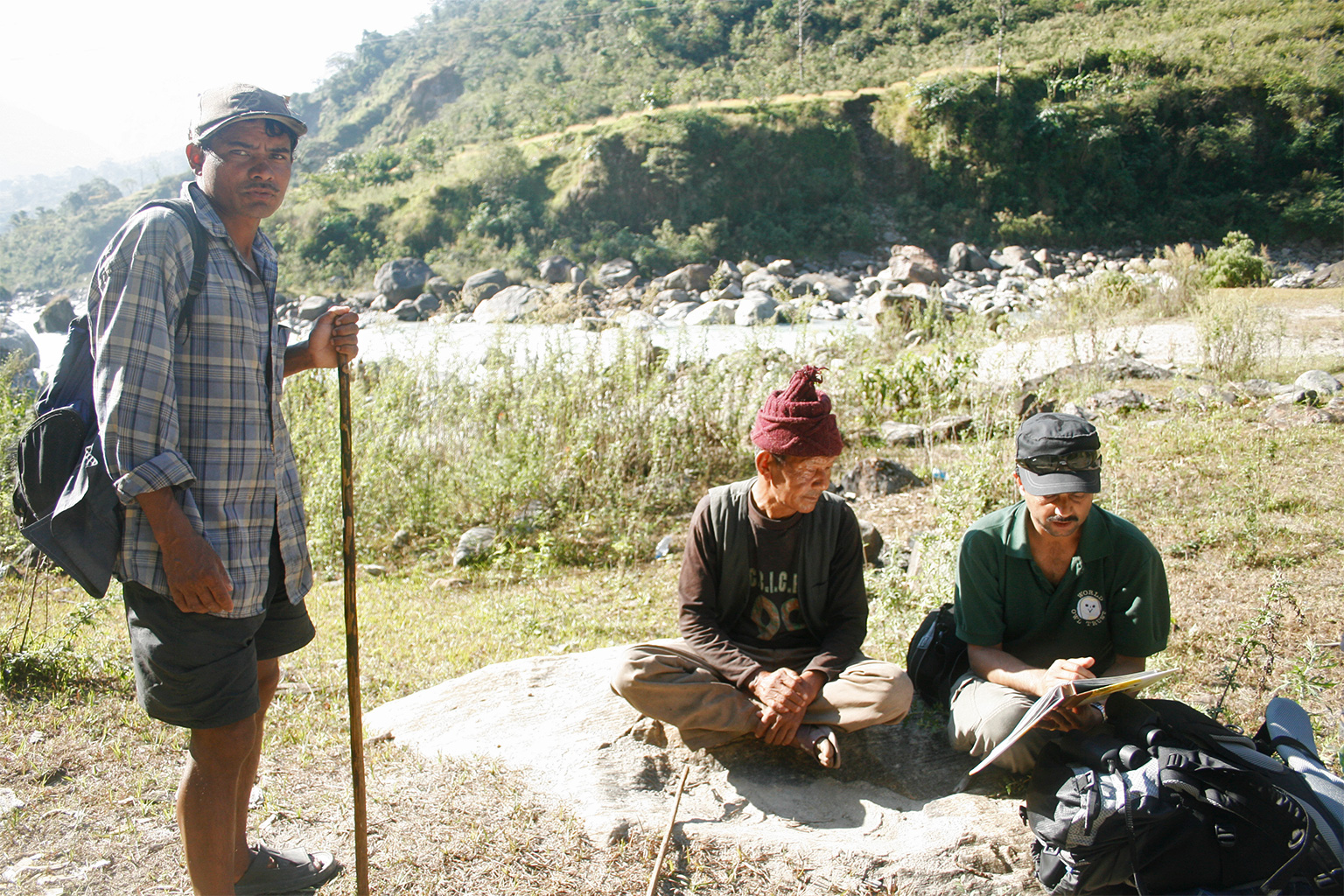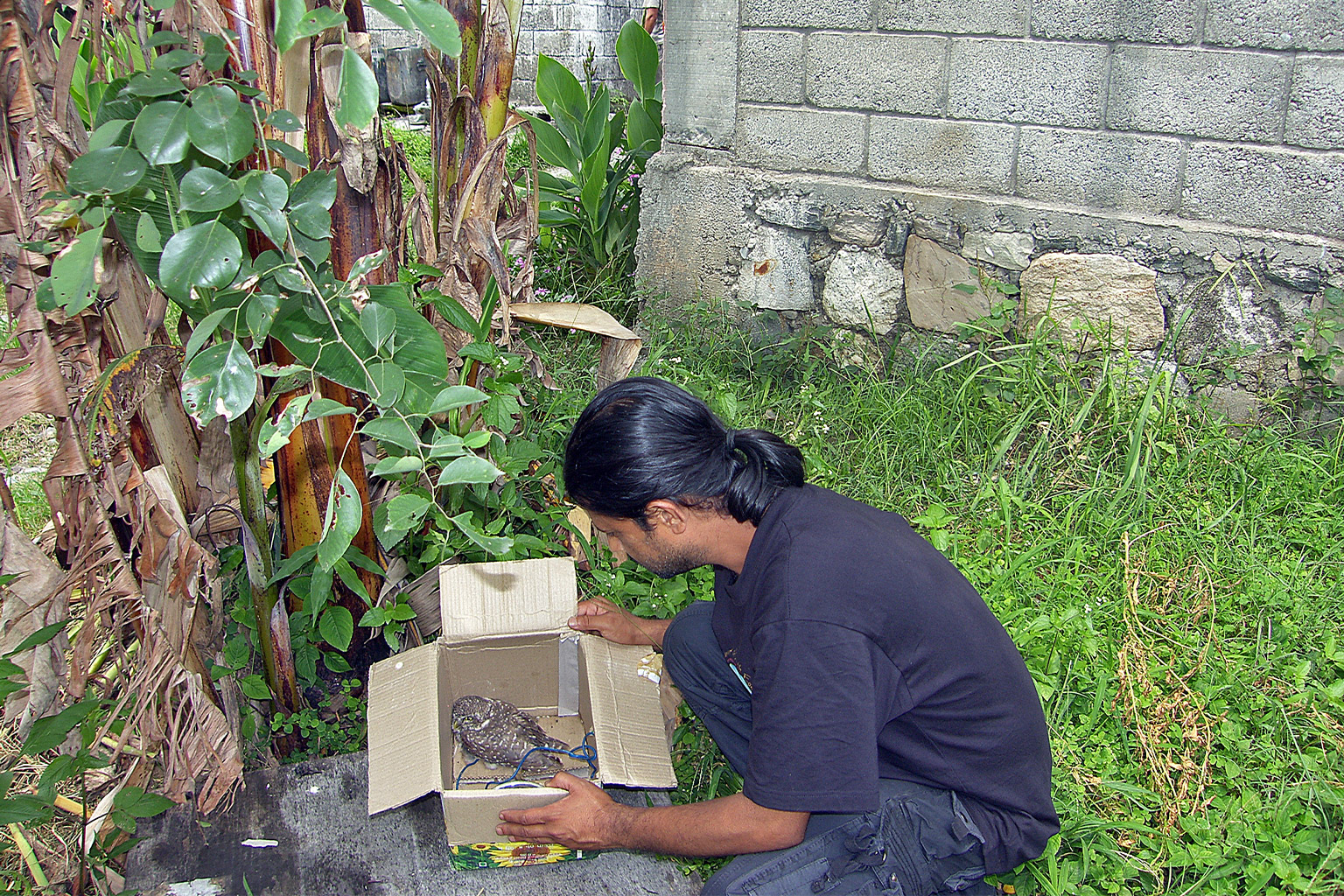- Raju Acharya, a pioneering owl conservationist in Nepal, shares his passion and challenges for studying and protecting the country’s 23 owl species, which are largely neglected by researchers and funding agencies.
- Owls face threats such as hunting, illegal trade, habitat loss and electrocution, but there’s insufficient scientific data to justify their classification as threatened, creating a vicious cycle of low conservation priority, he says.
- Acharya also talks about his initiatives to raise awareness and appreciation for owls among the public, such as organizing an annual owl festival, visiting schools, and engaging with local communities.
KATHMANDU — Nepal’s owls are perhaps the least-studied birds in the country, often overlooked by researchers more focused on the rarer vultures and cranes. Yet owls also face the same threats other birds face across the country, from habitat fragmentation and degradation, to electrocution on power lines and poaching.
While owls are often perceived as “wise” in other parts of the world, here they’re known as latokosero, or “bird that’s not clever.” None of the owl species found in Nepal are considered threatened under IUCN Red List criteria, which means there’s less motivation for researchers to study them, says owl conservationist Raju Acharya.
Acharya has been working in the field for the past decade and a half, cataloging the various species, examining their significance to local communities, and identifying the threats they face.

Mongabay’s Abhaya Raj Joshi caught up with Acharya in Kathmandu recently to learn more about his work and passion for owls. The following interview has been translated from Nepali and edited for clarity.
Mongabay: Could you tell us how you got into studying owls?
Raju Acharya: I completed my bachelor’s and master’s degree in Environment Management in the late 1980s. Basically, both my degrees focused on forestry, but the thesis I did for the degrees were on wildlife.
When I was working in Mustang district, in the trans-Himalayan region of Nepal, I had the opportunity to go birdwatching with Rinjan Shrestha, a senior conservationist. That opportunity kindled my interest in birds of different shapes and sizes.
Around 2007, I was studying in Germany when I emailed different organizations around the world to collaborate on bird conservation. One of the organizations I wrote to was the World Owl Trust, a London-based organization. I told them that we have preliminary information on owls in Nepal and asked them if there was any opportunity to collaborate. Within a few days they wrote back, asking me if I would be interested to volunteer as their representative in Nepal.
I agreed to volunteer, and since then I have been working on owls in Nepal.

Mongabay: Do you remember the first few years of your owl conservation career?
Raju Acharya: The first major survey we carried out was in Manang and Mustang districts in 2008. Back then, around 19 owl species were recorded in Nepal [the number has gone up to 23 today], and 13 of them were found in the Manang and Mustang regions. That motivated us to visit the area to look for owls.
This was also the first time we used bioacoustics to survey owls in Nepal. Under this method we produce owl sounds, and when the owls hear this sound, they respond and we record their presence.
Since then, we have visited 69 of the 77 districts of the country and carried out extensive social and cultural surveys in 45 districts.
Mongabay: What’s the distribution of owls like in Nepal’s mountains, hills and plains? How do people perceive them?
Raju Acharya: We have recorded the presence of owls [at elevations] up to 5,200 meters [17,000 feet] in Nepal. Generally, the higher up we go, the size of the owl increases. The bigger owls are found at higher locations.
Owls have been found to live in different habitats across the country. For example, the barn owl [Tyto alba] lives close to human settlements. Some owls live on trees, others build nests in grasslands. Although we don’t have strong evidence, we have reasons to believe that the long-eared owl [Asio otus] visits Nepal during the winter from China and Mongolia.
It would be difficult to generalize the perceptions of people toward owls. For example, the Tharu people aren’t fond of the birds. They believe that if they see an owl near the house, someone in the family will soon die. But in Mustang, they consider owls as a good-luck charm. When the people move to lower elevations in winter to escape the cold, they place a feather of a crow along with a feather of an owl on the door, believing that the crow will look after their house during the day and the owl at night.

We have also seen hotels and restaurants rear captive owls, believing that they bring good luck and money. Some people have a misconception that they can earn money by selling live owls.
Owls are one of those birds that are shrouded in mystery, not just in Nepal, but worldwide. If you go home and ask any of your family members, they would know at least a few things about owls. But the things they know wouldn’t be based on facts. Maybe it’s because they come out at night when people have gone to bed.
Some people believe that owls can only see at night. That’s not the case. They can see during the day as well. But their vision is better at night. Owls have big eyes compared to other birds. The eyes cover around 5% of the body and have very active rod cells that are very sensitive to light. This means that they can see better in low light.
One of the most interesting facts about owls is their rivalry with crows. This has also been documented in various Hindu religious texts. People believe that owls come out of their resting place only when the crows go to sleep. However, that’s not always the case.

Mongabay: You said that research into owls in Nepal has been limited. There’s a dearth of scientific literature. Why do you think that’s the case?
Raju Acharya: If you observe the trend these days, both researchers as well as funding organizations focus on charismatic species such as tigers [Panthera tigris] and elephants [Elephas maximus], and smaller animals such as fishing cats [Prionailurus viverrinus] and wild dogs [Cuon alpinus]. This means that there’s not enough funding available for research in owls as none of the 23 species found in Nepal are globally recognized as threatened.
Although they face a host of threats, there’s not much scientific literature to justify their classification as threatened. It works as a vicious cycle. Having said that, two of our studies are in the pipeline.
Mongabay: Talking about the threats, what are the major threats owls face in Nepal?
Raju Acharya: Owls face the same threats that other birds face in the country. But hunting and illegal trade are the major ones.
Back in 2011, when I was visiting Dhading district, which shares its border with the Kathmandu Valley, I saw for myself that a couple of youngsters had killed an owl and barbequed it to eat with alcohol.

Mongabay: What about the illegal trade?
Raju Acharya: I’ve had the opportunity to talk to around six or seven traders during my career. I met one of them a few weeks ago. He told me that he made a lot of money by selling them in the market, but it’s difficult to find them in his village these days.
Owls are valuable to traders only when they’re alive; they aren’t worth anything when they’re dead.
There’s an active network of illegal traders in Nepal that send live owls to India, where they’re used by traditional “black magic” practitioners. Their feathers are used to treat anxiety and panic attacks.
Also, until a few years ago, it was reported that thousands of owls were sacrificed in India’s capital New Delhi on the occasion of Tihar [also known as Deepavali in India]. People believe that sacrificing owls before Laxmi, the goddess of wealth, brings them wealth. We have evidence to believe that owls from Nepal were also trafficked to New Delhi for the rituals.
They also find their way into neighboring China, where owls are used in traditional medicine.
Based on the information we received from traders, around 2,000 owls were being removed from the wild every year to meet the demands of the pet and illegal trade markets. In the past few years, the number has gone down to around 1,500.

Mongabay: What are some of the reasons behind the decline?
Raju Acharya: I think the main reason is rising awareness among people and law enforcement officials. Until a few years ago, people could easily carry owls, even cross the border, and openly rear them in hotels and restaurants. When people complained to the police, they didn’t know that it was illegal. But these days, it’s next to impossible to carry out the trade in the open. Also, we’ve found that the trade has declined in different hotspots across the country.
Mongabay: Let’s talk about the annual owl festival you organize. How did the idea come about?
Raju Acharya: Around a decade ago, when I was in the U.S., I got the opportunity to attend an owl festival there. I was amazed that thousands of people gathered in one place to discuss owls for more than a week. I wondered if we could do something similar in Nepal. That’s how the annual owl festival was born. We organize it in the first week of February every year. We’ve been organizing the festival for 10 years now and directly engaged with more than 60,000 people.
The first festival saw only 180 people participate and it lasted only three hours. But since then, we’ve had thousands of people attend the festival, which is usually a week long.
During the festival, we have people dance, sing and play traditional games, with owl conservation being the major theme. Ahead of the festival, we visit the local schools where we plan to organize the festival that year and talk to the students about owls and how they can play their role in conservation. I think this has helped raise awareness about owls on a big scale in Nepal.

Mongabay: You helped prepare a national owl conservation action plan. As the plan enters its third year, how do you rate its effectiveness?
Raju Acharya: First of all, it’s a big achievement that the government prepared an action plan for neglected species such as owls. It took a lot of lobbying and convincing to get the government to agree.
It took us around a year to prepare the 10-year plan. But the first few years of its implementation were lost due to the COVID-19 pandemic. The main concern is the budget to implement the plan, which is inadequate. Nepali conservation officials are still reluctant to consider owls as wild animals.
Mongabay: Finally, do you agree with the Nepali name given to the birds?
Raju Acharya: [Smiles.] I don’t agree. Owls can do quick math in their heads. They can rotate their heads 270 degrees and plan precise attacks on prey such as rodents. They’re very clever and accurate.
Banner image: Raju Acharya in the remote field in Accham district, western Nepal. Image © Bikash Ghimire.
Abhaya Raj Joshi is a staff writer for Nepal at Mongabay. Find him on 𝕏 @arj272.
Bird-counting app kindles interest in Nepal’s rich avian life
